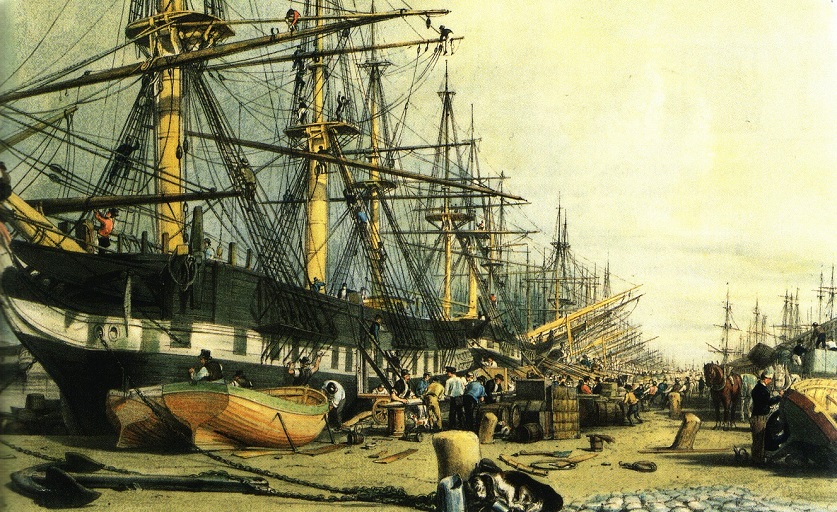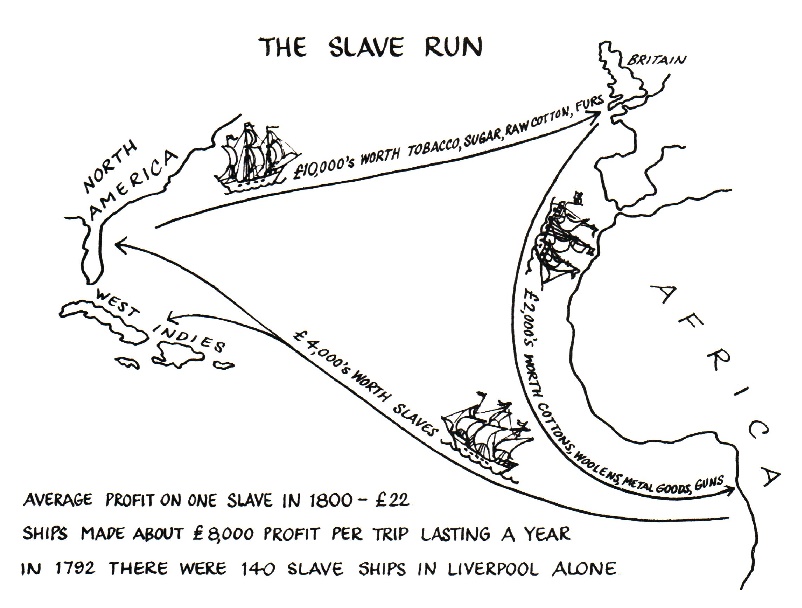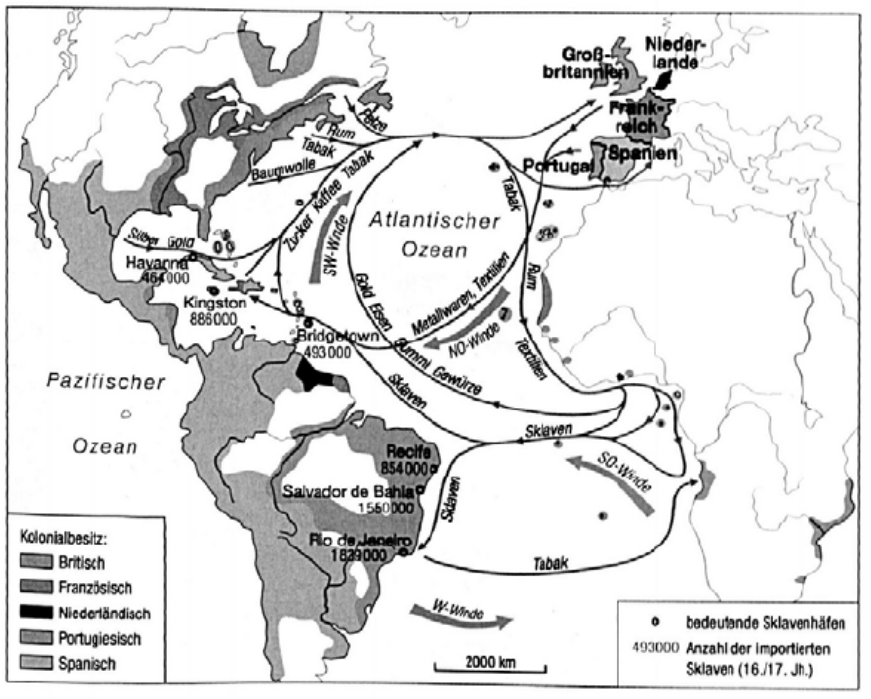
A Triangular Trade?

Introduction – Part I
The slave trade involved a voyage of three stages. For this reason, it is sometimes called `the triangular trade'.
The British wanted the produce of the West Indies: sugar, rum, cotton and tobacco. The planters of the West Indies were short of workers. As for the Africans, one of their tribal chiefs summed up their situation:
We lack three things: powder, shot [lead bullets] and brandy. We have three things to sell: men, women and children.
Slaving ships sailed from one of the ports connected with the slave trade, mainly London, Bristol and Liverpool Their cargoes included cloth, hats and caps, iron bars, all sorts of hardware from swords to saucepans, guns, shot and gunpowder, salt, and worthless trinkets such as beads and bells.
This cargo was taken to ports such as Benin in Africa, where it was exchanged for slaves. The ships then sailed to America, or Barbados and Jamaica in the West Indies, where the enslaved Africans were sold (the voyage across the Atlantic was called 'the Middle Passage'). The slave traders were sometimes paid in cash, but often they took payment in kind, returning with sugar, rum, cotton or tobacco to sell in Britain.
The slave trade was very profitable, but there were risks at every stage. In Africa there might not be a cargo of slaves ready, and the crew could fall ill or be attacked while they waited. On the Middle Passage there was a chance of epidemic or mutiny; it was usual for a third of the enslaved to die. Finally, the slave trader might arrive back in Britain to find that he could not sell his cargo at a profit because there was a glut on the market.
After you have studied this webpage – including the important Update below – answer the question sheet by clicking on the 'Time to Work' icon at the top of the page.
Links:
The following websites will help you research further:
The Slave Trade:
•
A traditional narrative (BEWARE: cointains errors.) •
Importance of the slave trade to the British economy (BBC Bitesize.)
See also:
•
A fantastic animation showing
how enslaved people were taken from Africa.
1 Unloading Sugar and Rum at the West India Docks, London
In 1944 the West Indian scholar Eric Williams suggested that the huge wealth flowing into Britain from the sugar trade helped to kick-start the Industrial Revolution. Although most historians now dispute this, it is possible that – as one of the first mass-produced luxury commodities – sugar played a major part in creating a consumer market in Britain.

2 A typical textbook illustration of the Triangular Trade (1970)

Introduction – Part II
Update
It now seems that the 'Triangular Trade' is much exaggerated – that it is a myth which has been regularly discredited since the 1880s! Yet still this error lumbers on in school textbooks.
The facts of the case seem to be:
• five million of the 12 million Africans transported across the Atlantic were taken to Brazil on ships which had sailed from Brazil to buy them;
• school students in the United States learn their own version of a 'triangular trade', which claims that merchants sailed from America, to Britain, to Africa, and then back to America; this too is a myth – most American trade with Britain was bilateral (i.e. direct between the two), and American slave ships traded direct with Africa or the Caribbean;
• until the 1750s the West Indian slave traders brought enslaved people direct from Africa on their own ships, and Cuba imported enslaved people direct from Africa after 1807;
• most of the trade between Britain and the West Indies was bilateral, as was trade between Britain and Africa – Britain imported gold, ivory, spices, palm oil, leather goods, rice, millet, and dyes direct from Africa;
• some ships sailed a quadrilateral (from Europe to Africa to the West Indies to America to Europe) and the trade has also been described as an 'H' (between America and the West Indies, amd between Africa and Europe, with some ships crossing the Atlantic);
• whereas it is true that thousands of ships sailed from Europe to sell enslaved people in the West Indies, since the cost of the ship was a minor part of the cost of the trip, many ships did not sail back to Britain, and of those that did only a third carried a full cargo – slave ships were not fit to carry a normal cargo;
• slave traders did not make their money from a sugar cargo brought back from the West Indies – most of the profit came from trade deal which arrived on other ships over the next two years.
Two more myths:
To the overall myth of the 'triangular trade' you must add two more myths:
1. that European
traders "dazzled Africans with third-rate goods and cheap tat"
This is just a racist trope – African traders knew exactly what they were doing, and mostly imported iron and silver;
2. that the transported Africans were mostly male
This is just a European
prejudice against women – African women were skilled in farming, trade
and building, and a third of all those transported were women.
3 Why do we still teach this myth?
This comment was written by the American historian Gilman Ostrander in 1973:
How is the appeal of this never-proved yet enduring notion of the triangular trade to be accounted for? Certainly a good deal of its attraction comes from the charm of its diagrammatic simplicity. Thus textbook accounts have frequently been illustrated with neat charts of a transatlantic triangle – one leg labeled "rum," another "slaves" the third "molasses" – easy for the student to grasp and remember.
4 The Actual Slave Trade
This illustration in a German textbook seeks to do more justice to the complexity of the Slave Trade. Amazingly, however, the caption to the map simply re-states the old myth!

Triangular trade: The merchant ships travelled in a triangle from Europe to Africa and America back to their starting point.